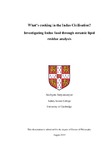This thesis investigates which products were used in ceramic vessels by populations of the
Indus Civilisation through ceramic lipid residue analysis. It uses concepts of food choice
and foodways to explore the culinary practices of Indus populations.
Specifically, the thesis examines how vessels may have been used in urban and rural Indus
settlements located in northwest India during the urban period (c. 2600/2500-1900 BC),
and identifies whether changes in vessel use occurred in the post-urban period (c. 1900-
1300 BC). It also analyses a small sample of Arabian and Indus-origin vessels from the
Umm an-Nar period (c. 2400-2000 BC) in the Sultanate of Oman.
As the first large-scale investigation into Indus foodstuff and vessel-use using lipid residue
analysis, the thesis first tests the viability of the method in the South Asian context. It
compares lipid yields from pottery recovered from collections, washed pottery from recent
excavations, and unwashed pottery from fresh excavations. It then integrates the molecular
and compound-specific isotopic data with available bioarchaeological evidence from the
study region to reconstruct which products were used in vessels at different sites.
The results indicate that overall, lipid residues are typically poorly preserved in Indus
vessels, but the acidified methanol extraction technique provides a good lipid recovery
rate. No significant differences in lipid yield are observable between washed pottery
samples and those collected directly from the field, which suggests that washed pottery
may serve as a good source for samples for future lipid residue analysis. However, it is
difficult to interpret lipid evidence from samples obtained from collections with limited
contextual information, suggesting that future lipid analyses in South Asia must be
carefully planned to yield optimum results.
The molecular results indicate that animal fats were primarily used in vessels, with minor
indications of plant products. The compound-specific results suggest processing of
different animal fats, primarily non-ruminants, however, equivocally, many vessels may
also have been used to store or process mixtures of products. Inter-site differences in vessel
use are observed, but there are broad similarities in vessel-use between urban and rural
sites. No change over time in vessel use is observed at rural sites, suggesting stability of
food choices. No correlations are observed between vessel-form and products used in
vessels, indicating their multifunctionality. These results provide a new means by which to
investigate Indus foodways, broadening our understanding of what ancient Indus cuisine at
both urban and rural settlements may have looked like.
Keywords
Indus Civilisation, lipid residues, foodways, ceramics, climate change, South Asia
Rights
Attribution-NonCommercial-ShareAlike 4.0 International (CC BY-NC-SA 4.0)
Date
2020-07-17
Awarding Institution
University of Cambridge
Author Affiliation
Department of Archaeology
Qualification
Doctor of Philosophy (PhD)







No comments:
Post a Comment